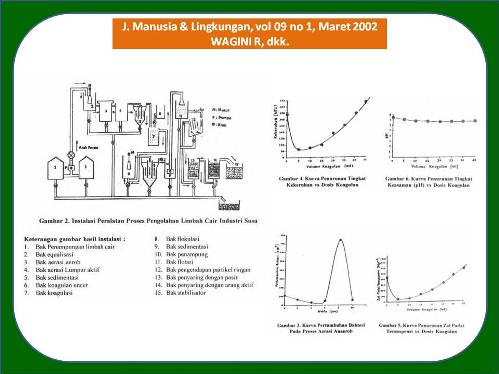
PENGOLAHAN LIMBAH CAIR INDUSTRI SUSU (Liquid Waste Management in Milk Factory)
Wagini Wagini(1*), Karyono Karyono(2), Agus Setia Budi(3)
(1) Jurusan Fisika FMIPA UGM
(2) Jurusan Fisika FMIPA UGM
(3) Jurusan Fisika FMIPA UGM
(*) Corresponding Author
Abstract
ABSTRAK
Telah dilakukan suatu penelitian untuk mengetahui kondisi limbah cair industri susu. hasil penelitian menunjukkan bahwa limbah cair industri susu mengandung zat-zat pencemar dalam tingkat yang membahayakan lingkungan, sehingga limbah cair tersebut perlu didaur ulang. Untuk itu diperlukan suatu instalasi peralatan yang mampu mengolah limbah tersebut. Pada penelitian ini proses pengolahan dilakukan dengan mengkombinasikan proses-proses pengolahan secara Fisika, Kimia dan Biologi. Dengan tahapan proses pengolahan yang dipilih meliputi; Proses equalisasi, proses anaerob, proses aerasi, lumpur aktif, proses sedimentasi, proses koagulasi-flokulasi, proses sedimentasi, proses flotasi, proses pengendapan partikel ringan, proses penyaringan dengan pasir dan arang aktif. Kualitas air hasil pengolahan dianalisa secara Fisika, Kimia dan Biologi melalui parameter-parameter: suhu, kekeruhan, zat padat tersuspensi, zat padat terlarut, daya hantar listrik, PH, BOD, COD dan jumlah bakteri. Penelitian ini menunjukkan air hasil pengolahan aman untuk dibuang ke lingkungan.
ABSTRACT
A research to identify the condition of milk industry liquid waste was conducted. The result showed that the waste contained pollutants at the level the endangered the environment. Therefore, the waste had to be recycled in which a liquid waste treatment installation is needed. In this research, the process of milk industry liquid waste was done by combining processing techniques of physics, chemistry and biology. The processing steps include the processes of equalization, anaerobe, aeration, sedimentation, coagulation-flocculation, sedimentation, flotation, sedimentation, filtering with sand and activated carbon. The water resulted from the processes was analyzed in terms of physical, chemical and biological characteristics e.g. temperature, turbidity, suspended solid, solutes solid, conductivity, pH, BOD, COD and amount of bacteria. This research, shows that the water resulted from the treatment was safe for the environment.
Full Text:
Artikel lengkap (PDF) (Bahasa Indonesia)Article Metrics
Refbacks
- There are currently no refbacks.
Copyright (c) 2017 Jurnal Manusia dan Lingkungan







